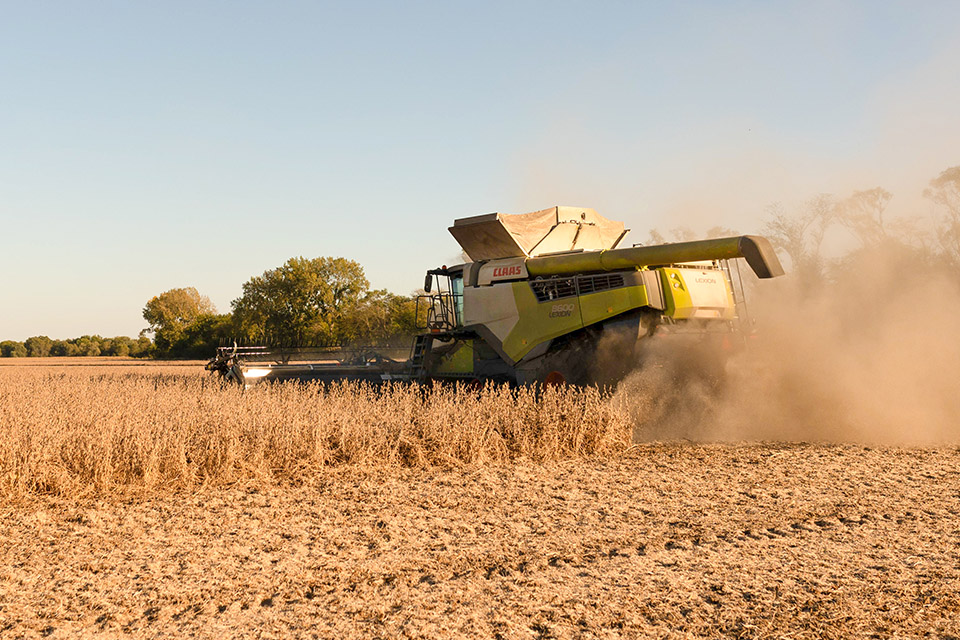
(Photo: Iowa Soybean Association / Joclyn Bushman)
November WASDE increases U.S. soy numbers
November 16, 2023
November’s World Agricultural Supply and Demand Estimates (WASDE) report from the U.S. Department of Agriculture (USDA) yielded few surprises, but numbers are always fluid.
The U.S. soybean outlook for 2023/24 was at 49.9 bushels per acre (bpa) to produce 4.13 billion bushels. That’s above the October estimates of 49.6 bpa and 4.104 billion bushels.
With crush and exports unchanged, soybean ending stocks rose to 245 million bushels, compared to October’s estimate at 220 million bushels. The U.S. season-average soybean price for 2023/24 is forecast at $12.90 per bushel, unchanged from last month. The soybean oil price is reduced 2 cents to 61 cents per pound. The soybean meal price is unchanged at $380 per short ton.
“The November WASDE is always an interesting report. The USDA uses farmer surveys to gather information about yield, so it wasn't a huge surprise when the bean yield was slightly raised to 49.9 bpa, from 49.6,” says Kristin Stien, a grain marketing advisor for Ever.Ag, an Ag Tech company providing information on innovation and technology, risk management and market intelligence.
“The common saying among growers in regard to their bean yields were ‘they were better than expected, given what the weather was like in the month of August.’ That's why we saw the USDA increase the average yield. That doesn't mean that yield can't be adjusted going into December and January reports,” Stien says.
Iowa Soybean Association (ISA) District 7 Director Scot Bailey of Anita says November’s report was not expected.
“I was surprised with the increase in the yield and the carryout due to the drought in many areas of the United States,” he says.
But ISA At-large Director Aimee Bissell from Bedford says WASDE numbers will always fluctuate.
“For me, I like report days and the days prior to and following,” she says. “They are just numbers that can create windows of pricing opportunities. We need volatility in the market and a report, or a report prediction can do just that.”
She doesn’t focus as much on the production numbers, she says.
“I don't get caught up in the precise numbers, I focus on the trends or opportunities that can be captured,” Bissell says. “As I sit here today (Nov. 15), beans are up 17 cents from Nov. 8. The report did not look favorable, but the markets are like Iowa weather - if you don't like it today, just wait until tomorrow.”
Global numbers
The WASDE report notes that global 2023/24 soybean supply and demand forecast include lower beginning stocks, higher production, higher crush and lower ending stocks. Beginning stocks are reduced 1.6 million tons, reflecting offsetting back-year balance sheet revisions for China and Brazil.
USDA says China’s beginning stocks were reduced on lower soybean imports for 2021/22 and 2022/23 and higher crush for 2022/23. Brazil’s beginning stocks are increased on a larger 2022/23 crop of 158 million tons due to higher-than-expected use to date. Global 2023/24 soybean production is raised 0.9 million tons to 400.4 million, mainly on higher production for Russia, Ukraine and the United States. Global soybean crush is raised on higher crush for China and Russia. Global soybean ending stocks are reduced 1.1 million tons as higher stocks for Brazil and the United States are more than offset by lower stocks for China.
“With domestic stocks being on the lighter end of the historical balance sheet, a huge focus will be on global stocks,” says Stien. “As the world sits, we have decent ending stocks numbers, but we have to keep in mind that the United States lowered stocks by 1.1 million tons without even touching South American production. Higher crush for China and Russia is to thank for that.”
Price opportunities
Stien says any decrease in U.S. and/or South American production can leave beans in a “very supportive price situation.”
The downside risk, she says, lies in South American weather turning more favorable and/or corn continuing to grow the balance sheet and providing downside pressure to beans.
The November WASDE report indicates corn at 174.9 bpa to produce 15.234 billion bushels. That’s up from October’s estimate of 173 bpa and 15.064 billion bushels. The WASDE report indicated 2023/24 corn ending stocks at 2.156 billion bushels vs. the trade's estimate of 2.144 billion and October’s estimate of 2.111 billion bushels.
The USDA listed world corn ending stocks for 2023/2024 at 315 mmt, up from October’s estimate of 312.4 mmt.
Back